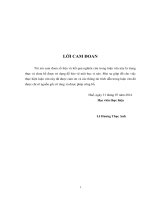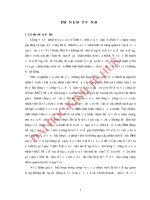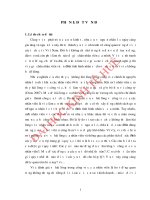ĐÁNH GIÁ sự hài LÒNG với CÔNG VIỆC và CAM kết với tổ CHỨC của các GIẢNG VIÊN đại học và CAO ĐẲNG KHU vực MIỀN bắc e
Bạn đang xem bản rút gọn của tài liệu. Xem và tải ngay bản đầy đủ của tài liệu tại đây (310.25 KB, 87 trang )
Luận văn thạc sĩ
ĐÁNH GIÁ SỰ HÀI LÒNG VỚI CÔNG
VIỆC VÀ CAM KẾT VỚI TỔ CHỨC CỦA
CÁC GIẢNG VIÊN ĐẠI HỌC VÀ CAO
ĐẲNG KHU VỰC MIỀN BẮC
ASSESSMENT OF THE JOB SATISFACTION
AND COMMITMENT TO ORGANIZATIONS OF
LECTURERS FROM THE NORTHERN
UNIVERSITIES AND COLLEGES
Page i
TABLE OF CONTENTS
Page
Acknowledgements............................................................................................................i
Table of Contents..............................................................................................................ii
Abstract.............................................................................................................................v
Chapter I: Introduction.....................................................................................................1
1.1 The necessity of the thesis..........................................................................................1
1.2 Research purposes.......................................................................................................1
1.3 Scope of Research.......................................................................................................2
1.4 Significance of Research.............................................................................................2
1.5 The organizational structure of Research....................................................................3
Chapter II: Review of Literature......................................................................................4
2.1 Job satisfaction............................................................................................................4
2.1.1 Definition............................................................................................................4
2.1.2 Theories of Job satisfaction.................................................................................5
2.1.3 Impacts of environmental factors on Job satisfaction.........................................6
2.1.4 Demographic factors affecting job satisfaction...................................................7
2.1.5 Research on job satisfaction..............................................................................10
2.2 Commitment to organization....................................................................................12
2.2.1 Definition of Organizational commitment - Allen and Meyer’s model of
organizational commitment........................................................................................13
2.2.2 Factors affecting organizational commitment...................................................18
2.3 Relationship between job satisfaction and organizational commitment...................22
2.4 Summary Chapter II..................................................................................................25
Chapter III: Real situation of the system of universities and colleges in Vietnam and
Research Methodology................................................................................27
3.1 Real situation of the system of universities and colleges in northern Vietnam.......27
3.2 Research Methodology.............................................................................................33
3.2.1 Sampling...........................................................................................................33
3.2.2 Data Collection.................................................................................................33
3.2.3 Tools (Questionaire Design).............................................................................34
Page ii
* Demographic..................................................................................................34
* Servey on satisfaction of lecturers.................................................................34
* Servey of commitment to organization..........................................................36
3.2.4 Data analysis .................................................................................................39
3.3 Research questions...................................................................................................40
Chapter IV: Analysis of Study........................................................................................41
4.1 Sort out data.............................................................................................................41
4.2 Study results for Questionnaire................................................................................41
4.3 Summary..................................................................................................................47
Chapter V: Conclusion and Practical solutions............................................................49
5.1 Conclusion...............................................................................................................50
5.2 Practical solutions....................................................................................................58
5.3 Suggestions for further researches...........................................................................60
REFERENCES...................................................................................................62
Page iii
Appendics
Appendix 1. Survey: Demography.................................................................................64
Appendix 2. Survey on the job satisfaction of the lecturers...........................................65
Appendix 3. Table for evaluation of commitment to an organization............................67
Appendix 4. Demographic characteristics of lecturers in the survey ............................69
Appendix 5. Order of sources creating job satisfaction .................................................70
Appendix 6. Levels of commitment to the organization.................................................72
Appendix 7. Relations between job satisfaction and gender ........................................75
Appendix 8. Relations between job satisfaction and marital status .............................76
Appendix 9. Relations between job satisfaction and title...............................................77
Appendix 10. Relations between job satisfaction and administrative work ..................78
Appendix 11. Relation between continuous commitment with .......................................79
organization and marital status
Appendix 12:Relation between continuous commitment to the .....................................80
organization and title
Appendix 13:Relation between staying commitment to the organization.......................81
and administrative duty
Appendix 14: Connection between job satisfaction and high commitment....................82
to the organization
Page iv
Abstract
As mentioned in many previous researches, employees’ behavior and attitudes
toward their organization have many considerable impacts on their performance and
the organization’s results. The author carried out the research on the purpose of
understanding more about lecturers’ satisfaction with their job and their
commitment to the Northern universities and colleges in Vietnam.
Today, there are some continuous changes in style of management of the
universities and colleges in Vietnam, especially in the Northern area, as well as in
their staffs’ life. As a result, leaders of the schools should understand staffs in terms
of their job satisfaction and commitment to the organization.
The findings of the research were found through surveying two types of factors in
terms of internal and external ones, three kinds of commitment including
continuous, emotional and normative ones. Moreover, the findings show the
relationship among these above factors and demographic variables such as age,
gender, marital status, working time, position, administrative task holding. Based on
these results, the study suggests some solutions for the universities and colleges to
enhance lecturers’ job satisfaction and commitment, improve the quality of taught
contents.
The research wills help organizations know how to improve employees’
commitment and their own performance. The thesis also suggests some
recommendations for further researches.
Page v
CHAPTER I: INTRODUCTION
1.1 The necessity of the thesis
Attitudes related to work and organizational behaviors have considerable impact on
many stages of organizations. Satisfaction of employees and commitment to
organization are really influences on work attitudes of employees.
In today’s world, changes become a lifestyle of organizations and members of
organizations. In the recent training reform and restructuring process, the concerns
have focused on the development of ways to improve commitment of lecturers and
staff to universities. Organizations should understand the levels of job satisfaction,
commitment to organization, especially when changes need releasing. Each lecturer
is an important part of university. They often interact with more students than any
other staff in the university. Lecturers’ job has differences based on helping,
encouraging and teaching students. A good university depends not only on good
equipment, good governance or size of the dormitory but also on reliable
relationships and stability of labor force.
In a strongly competitive environment in the field of training of Vietnam,
universities need to improve efficiency in the organization affairs through
increasing the level of job satisfaction of lecturers and their commitment to
organization.
1.2 Research purposes
This research assesses the level of job satisfaction of lectures and their commitment
to organization. At the same time, the research will determine the extent of
differences in evaluation of lectures’ satisfaction and commitment to organization
when distinguishing under the criteria such as age, gender, marriage status, working
time, degrees, and participation in management activities or non-participation in
Page 1
management activities. Moreover, this research also identifies the relationship
between job satisfaction and commitment to organization.
Research questions
This research will answer the following questions:
1. The levels of job satisfaction of lecturers in Vietnamese universities and
colleges?
2. The levels of lecturers’ commitment to their working environment?
3. Is there any relationship between job satisfaction of lecturers in colleges and
universities and the demographic variables: (a) age; (b) gender; (c) marriage
status; (d) working time; (e) academic level ranking; (f) administrative
management work?
4. Is there any relationship between the level of commitment to work and the
demographic variables: (a) age; (b) gender; (c) marriage status; (d) working
time; (e) academic level ranking; (f) administrative management work?
5. Is the job satisfaction of lecturers conditional enough to predict the long-term
commitment to work in the organization?
1.3 Scope of Research
Some complicated variables of the research include prerequisite factors,
relationship, and chain of results of commitment to organization. This research only
focuses on studying job satisfaction as a mainly prerequisite factor for commitment
to organization.
With the analysis samples and previous researches, this research will concentrate on
evaluating lecturers of universities and colleges in the Northern region in terms of
job satisfaction.
Page 2
1.4 Significance of Research
The research findings provide information about job satisfaction of lecturers as
well as their commitment to organization for leaders of universities and colleges.
The factors creating job satisfaction and explaining the rate of job changes or other
organizational behaviors will contribute to ideas of leaders in redesigning and
reorganizing the workplace.
Finally, the research findings can help universities and colleges to make
administrative decisions, for example, which lecturers continue to participate in
doctoral programs, what personnel policies are.
1.5 The organizational structure of Research:
This thesis is divided into chapters:
Chapter 1: Introduction
Chapter 2: Review of Literature
Chapter 3: Real situation of the system of universities and colleges in Vietnam and
Research Methodology
Chapter 4: Analysis of Study
Chapter 5: Conclussion and Practical solutions
Page 3
CHAPTER II: REVIEW OF LITERATURE
2.1 Job satisfaction
2.1.1 Definition
Job satisfaction mentions positive or negative attitudes towards current job
(Robbins, 2000). Job satisfaction is also defined as the level at which rewards are
received due to meeting requirements (Poster, 1961). According to another simple
definition, job satisfaction is the level at which a person love his job very much
(Spector, 1997).
There are two schools mentioning concepts and definitions of the level of job
satisfaction. The first trend is to consider job satisfaction at the macro or global
level, in which a survey is designed to evaluate the overall feelings of work.
Although job satisfaction is considered as a general phenomenon, the problem
which should be emphasized here is evaluation of job satisfaction (Jayanratne,
1993). The simple survey question is “In general, do you feel satisfied with your
job?”
The second trend emphasizes on a lot of aspects of job satisfaction in which the
survey instrument will measure the different aspects of each job. It is obvious that
job satisfaction is the level at which an individual is satisfied with all the aspects of
their job (Jayaratne, 1993). The whole job satisfaction is the combination of many
aspects which are assessed on job. In general, those assessed aspects include
satisfaction with payment, supervision in work, work safety, work overload and
working conditions.
Job satisfaction becomes important because of three reasons:
First, according to the viewpoint of humanity, employees should be treated with
fairness and respect. Job satisfaction reflects good treatment.
Page 4
Second, according to the practical viewpoint, job satisfaction of employees will
create positive behaviors for operations of organization, etc…
Finally, job satisfaction can be shown in the process of implementing enterprises’
functions.
2.1.2 Theories of Job satisfaction
The theories of needs and encouragement: Needs of human help to orient
encouragement. All incentives arise when needs of human have not been met yet.
The theory of needs of Maslow (1943) created the basis for experimental researches
on behaviors and attitudes of human. The lowest level in Maslow’s Hierarchy of
Needs is material needs, the next levels is safety needs, emotional exchange needs,
respected and loved needs and self-expression needs. In general, the needs at the
low level should be met before the needs at the higher level arise.
However, the researchers have not found much support in Maslow’s theory for the
research. Employees still like the pattern of “bread and butter” as a safe pattern and
are made higher payment with the immaterial things such as the variety of work.
The expectancy theory: In 1964, the expectancy theory of Vroom suggested that job
satisfaction of an individual originates from the difference between what employees
expect and what they obtain. The obtained things can include material or immaterial
rewards. There are three variables in the difference of Vroom’s theory:
attractiveness of potential output, belief in efforts to lead to good performance, and
expectations of good performance to lead to output achievements (Robbins, 2000).
When mentioning the evaluation method of job satisfaction, it is necessary to
recognize what people want, what people think they should obtain and what they
expect to obtain. Therefore, job satisfaction of human is determined through the
general difference between “what an individual gets and his desires, what the
obtained value is and needs, what the obtained value is and expectations”
(Jayaratne, 1993).
Page 5
The two-factor theory: In a research on “motivation” in 1959, Herberg and
colleagues studied job satisfaction and needs of human. A series of needs is
identified under the human instinct: building factors to prevent damage from
environment and factors to adapt to environment in order to meet basic biological
needs (Herberg, 1964). The factor introducing the behaviors which do not offer
customer’s satisfaction can be found in the working environment. External factors
or hygiene factors related to dissatisfaction include: salary, job position, safety,
relationship among individuals, supervision, working conditions, policy and
administration. Another group of factors is the group related to the ability of
individuals in order to gain and through psychological and physical development
experiences. Motivation for growth demands occurs in work. Internal factors or
motivation related to development include achievements, recognition to
achievements, responsibility and development.
These theories are usually utilized in the researches on job satisfaction of employees
and prediction of employees’ performance. Job satisfaction is the subjective reaction
of an individual for his job. In addition, job satisfaction is the perception of
individuals in which each employee assesses the working experiences in the
personal context and environmental factors. Because job satisfaction is relevant to
personal characteristics, evaluation is very difficult.
2.1.3 Impacts of environmental factors on Job satisfaction
Based on the theories of Maslow (1943), and Herzberg and colleagues (1959), many
researchers try to offer characteristics of the working environment related to job
satisfaction for the higher levels of needs including loved needs and self-expression
needs. Turner and Lawrence (1965) found six characteristics of work to meet needs
at the high level. These characteristics consist of variety, autonomy, compulsory
interaction,
optional
interaction,
compulsory
responsibility.
Page 6
knowledge
and
skills,
and
Meanwhile, Hackman and Lawler (1971) suggested the factors such as variety,
autonomy, job awareness, feedback, working with others, and cooperation
opportunities.
In a survey of job analysis, Hackman and Oldham (1975) classified five main
factors of the working environment which decide the completion of high demands.
Factors related to psychology in work including: variety of skills, job identification,
work meanings, autonomy and feedback.
+ Variety of skills mentions the level at which job requires the diversity of
activities when implementing tasks, which is related to using a range of skills
and knowledge of workers.
+ Job identification is the level at which job requires the comprehensive
completion and implementation from the beginning to ending with the output
which can be measured (Hackman & Oldman).
+ Meaning of job is the level at which job has a significant impact on life or job of
other people regardless of in the organization or in the external environment
(Hackman & Oldham).
+ The autonomy is associated with the psychological condition of responsibility
for the outputs of the job.
+ Feedback from work and from supervisors or colleagues is also connected to the
psychological condition.
Other variables related to job satisfaction are stress, individual relationships and
working conditions.
2.1.4 Demographic factors affecting job satisfaction
In an effort to identify factors having influence on job satisfaction, a considerable
attention is focused on individual characteristics (Reiner, 1998). Variables on
Page 7
demographic factors which are often considered include: age, gender, marriage
status, and working period in organization.
Age
A lot of researches on impacts of age on job satisfaction have been reported. In
general, older employees tend to be more satisfied in their work than young people.
However, some arguments are released for the trend that older employees are often
more satisfied in their work than young people. First, prestige and confidence
gradually increase with age, so older employees seem to have higher job satisfaction
(Bedeian, Ferris, & Kacmar, 1992). Second, older employees want to reduce their
expectations for job through their working experiences while younger employees
tend to have higher expectations. Along with the perception of gap between current
working conditions and shorter ideal working conditions, older people often have
more positive attitudes towards job (Oswald & Warr, 1996).
Some researches show that job satisfaction is linearly related to age (Boker, 1994;
Quinn & Staines, 1979; Weaver, 1980), while other reports suggest that this
relationship is under U-Shape, which tends to reduce in the early years of work and
increase very quickly when employees are going to retire (Oswald & Warr, 1996;
Warr, 1992). The two processes of expectations can explain the U – shaped
relationship between job satisfaction and age. First, young employees often feel
satisfied with their job because of the high unemployment, and they feel satisfied
with the job which is more prestigious than their friends’ job. Second, when
employees have more experiences, they have information about job characteristics
compared to the expectations of previous jobs (Oswald & Warr). Therefore, it can
be concluded that age can be a predictive factor for job satisfaction.
Gender
The findings found in the researches on the relationship between gender and job
satisfaction in different jobs bring a lot of disputes. There is not any conclusion
Page 8
related to the level of job satisfaction between male and female (Brief & Oliver,
1976; Brief, Role, & Aldag, 1977; D’Arcy, Syrotuik). However, the researchers of
psychologists show that female employees tend to be less satisfied with their job
than their male colleagues in terms of salary, promotion, opportunity and respect of
their expertise (Black & Holden, 1998). The researches in the public and private
sectors for employees having different occupations and different position show that
female is less satisfied with their job than male in terms of salary and satisfaction
with the material environment (Reyhan, 1998). The research for teachers shows that
female teachers are often more satisfied with their expertise than male teachers (Ma
& MacMillan, 1999). A research found that satisfaction of male teachers is often
related to supervision, autonomy and job position while satisfaction of female
teachers is often related to factors such as complication, cleanness and income
(Miller, 1980).
In conclusion, gender must not be the factor having direct impacts on job
satisfaction. The difference about the level of job satisfaction seems to depend on
types of job and job characteristics.
Marital status
A numerous number of researches show that married employees are frequently more
satisfied with their job than single employees. However, some researchers suggest
that there is not obvious difference in job satisfaction related to married status or
unmarried status. Similar to gender, the relationship between marriage status and
job satisfaction is not applied to different occupations or similar occupations at the
same place. Marriage status seems directly unrelated to the determination of job
satisfaction. And differences seem to be caused by circumstances or other social
factors.
Working period
In general, the influences of working period are considered to have a high
Page 9
relationship to age. The positive relationship was found between job tenure and job
satisfaction (Hunt & Saul, 1975). Similar to the U-shaped relationship found in the
research on relationship between age and job satisfaction, a research found that
employees having little experience often have the high level of job satisfaction, and
then this level of job satisfaction gradually reduces until they have worked for about
16 years. After this time, job satisfaction will gradually increase (Burke, 1989). The
reason for this is the fact that new employees can find high challenges of job and
are motivated to work harder in order to find opportunities for promotion. When
working experience increases, they start to feel stable in their organization and feel
that there are very few challenges or no challenges or no opportunities for career
promotion in their job. They become undoubtful about finding job-perfecting
opportunities in their career. The levels of job satisfaction will gradually reduce
until they are going to retire.
Academic titles and degrees
Changes of academic titles and degrees bring different expectations, changes of
responsibility, job reputation and salary. Tack and Patitu (1992) found that job title
is a factor which helps to satisfy lecturers. For example, the title of professor shows
the higher satisfaction than the title of assistant professor. Promotion opportunities
in academic titles and degrees change concentration, concerns and objectives and
therefore have influence on their positive attitude toward job.
2.1.5 Research on job satisfaction
Research on job satisfaction can be divided into three groups (Reiner, 1998). In the
first group, job satisfaction is considered as a dependent factor while the purpose is
to find out the factors that have impacts on job satisfaction. The issues considered
here include characteristics of each individual, perception of working environment,
and job characteristics (Liacqua & Schumacher, 1995).
Page 10
In the second group, research on job satisfaction considers job satisfaction as an
intermediary factor related to characteristics in the working environment and the
quit rate of employees (Cammann, Fichman, Jenkins and Klesh, 1983). Job
satisfaction is also considered as an intermediary factor used to check the
relationship among job characteristics and working environment and commitment
of an individual in organization. For example, when evaluating the impacts of
individual characteristics and organizational characteristics on commitment to
organization, the results show that all the factors proposed can indirectly affect
commitment to organization through job satisfaction (Williams & Hazer, 1986).
In the third group, research on job satisfaction considers job satisfaction as an
independent variable in order to determine the influence on dependent Variables.
The researchers suggest that job satisfaction is related to the performance of the
company as the quit rate of employees, stress at work, absence and job
performance. The lecturers with high job satisfaction are often creative and
motivated to form and maintain a favorable environment for learning (Liacqua &
Schumacher, 1995).
Traditionally, a common scale is used to assess job satisfaction and job
dissatisfaction. The highest point is to measure the completely satisfied level with
the work while the lowest point is to measure the completely dissatisfied level with
the work. However, using a common scale to evaluate job satisfaction and job
dissatisfaction has some challenges. Truell, Price and Joyner (1998) suggested a
proposal that by exploiting different aspects of job satisfaction, the reasons related
to low job satisfaction were found and so it could support for improvement of job
satisfaction.
A lot of researches on job satisfaction have been applied the two-factor theory of
Hezberg (1959). Hezberg and colleagues suggested that job satisfaction is identified
by internal factors. In the educational environment, external factors are relevant to
the direct link between teachers and their repetitive tasks every day. These factors
Page 11
are related to academic, challenges on skills and abilities, perception of work
meanings, academic abilities of students, financial support for researches, ability of
a person to have a positive influence on others, positive feedback and identified
ability of learning, promotion opportunities (Liacqua & Schumacher). External
factors consist of bases of work or surrounding environment, including:
administrative management policies in the company, supervision, salary, benefits,
relationship among individuals, working conditions, job title, and job safety
(Herzberg, 1964).
The next theories will assess the previous researches and influences of job
satisfaction on commitment to organization.
2.2 Commitment to organization
Commitment to organization has been a popular topic for many decades (Randall,
Fedo, & Longenecker, 1990). Commitment to organization is an important part of
employees’ psychology because employees with long-term commitment to
organization often express positive attitudes toward the effectiveness of
organization. Commitment to organization among employees is assumed to reduce
behaviors such as quitting, absence and lateness (Mowday and colleagues, 1979).
Moreover, employees having commitment to organization tend to participate in
different behaviors, for instance creativity to improve business performance of
company and maintain competitiveness of organization (Katz & Kahn, 1978).
It is found that the success in change efforts of organization can depend on attitudes
of employees because changes become a lifestyle for organization and employees.
Individuals with commitment to objectives and purposes of organization will (a)
recognize and accept change efforts of organization, (b) act to support changes of
organization, (c) become creative to change, and (d) implement under the way of
improving the flexibility of organization to adapt to changes of environment
(Becker, 1992). The researches of Becker provide attractive reasons for the
Page 12
definition of commitment (it is loyalty) as a factor to evaluate influences of changes
in organization on the relationship between staff and organization. Specifically,
readiness of staff to comply with regulations, policies and rewards of organization,
their commitment to organization and members of organization, and obtained values
in the process of changes will have impacts on staff’s sense to organization.
Organization’s commitment also affects the level at which individuals will perform
the work in the state of stress, doubt and attitude to withdraw from the workplace
(for example absence, lateness) and finally to quit job (Becker and colleagues).
• 2.2.1 Definition of Organizational commitment and Allen and Meyer’s
model of organizational commitment
The definition of organizational commitment mentions linked characteristics
between members and organization. The definition of organizational commitment
can be very various. Organizational commitment can be divided into the approaches
of attitude and behavior (Mowday, Porter, & steers, 1982; Reichers, 1985).
Attitude-based commitment
Attitude-based commitment reflects the thinking process of individuals in
determining their relationship with the organization. Through the thinking process,
individuals can form willingness to work with organization and its influences on
organization. Mowday and colleagues (1982) defined attitude-based commitment as
an individuals’ awareness of organization’s goals and their willingness to work in
order to achieve the goals. One of the popular methods to evaluate attitude-based
commitment is Organizational Commitment Questionnaire (OCQ) developed by
Porter in 1974. The OCQ is designed to evaluate desires to maintain relationships
with organization. For researches on commitment on attitudes, most of researches
focused on finding a precondition which contributes to building commitment and
behavior of this commitment (Mathieu & Zac, 1990).
Page 13
Behavior-based commitment
Approaches based on behavior related to the process in which an individual is
bound in their actions within organization. Through these actions, individuals will
develop the belief that they need to maintain these behaviors and commitment to the
organization (Salancik, 1977). Commitment on behavior is the method to assess
trends of an individual to stay with organization (Mowday and colleagues, 1982).
The theory of Becker (1960) on behavioral commitment suggested that individuals
are associated with organization through investment, for example investment in
time and efforts, which is very difficult to remove. Behavioral commitment is the
process in which individuals become attached in an organization and how they
make situations through behavior (Mowday and colleagues). For researchers on
behavioral commitment, these researches focus on finding conditions in which the
behaviors expressed will tend to repeat and this behavior will have influences on
change of attitudes (O’Reilly & Caldwell, 1980).
Attitude-based commitment and behavior-based commitment are interdependent.
Many researchers argue that there is a relationship between these two types of
commitment. It means that attitude-based commitment leads to behavior-based
commitment, and in turn consolidates the behavior.
Three topics of attitude-based commitment
Organizational commitment is described at least in the three topics including (a)
exchange approach, (b) psychological approach, and (c) regulation-based approach
(Meyer & Allen, 1997; Reichers, 1985).
-
Exchange approach: Exchange approach considers commitment as an exchange
result among reasons and contributions between organization and members of
organization. The commitment becomes a function to assess awareness of costs
and benefits of maintaining the organization’s members. The point which needs
to be emphasized here is existence of members as the main factor determining
Page 14
the benefits and disadvantages in this exchange process. Expectations about the
results from investments in time and efforts of individuals in the organization
and other rewards are recognized to help to create a contact between individuals
and organizations. Costs or opportunities can reduce desires to maintain
relationships within the organization. From this aspect, it is assumed that the
greater exchange value for employees is, the bigger their organizational
commitment will be (Hrebiniak & Alutto, 1972).
The theory of Becker (1960) defines commitment as a trend to participate in a
series of activities due to awareness of investment for this. The investment
related to leaving organization can include reduced benefits and seniority,
interruption in the relationship between individuals, efforts to find a new job,
etc… The term “betting” used here refers to any value that individuals invest
(for instance time, effort, money) that they cannot recover when they leave the
organization (Meyer & Allen, 1984). The betting simultaneously mentions the
member value of organization in some aspects of life. For example, a person is
not willing to leave work because they are afraid of that they are seen as “person
hopes job” (Reichers, 1985). In this case, individuals make a bet through stably
localizing their reputation in a certain organization. In general, the longer the
working time in an organization is, the more employees tend to apply this theory
of betting. The results of commitment include tenure, job position, academic
titles and degrees, rewards, other benefits and specific skills of organization. The
theory of commitment’s exchange frequently explains the significant
relationship between commitment to the organization and individual
characteristics such as age, working time in the organization. Exchange
approach does not help to predict how a person with long-term commitment will
do his job well.
According to Berker (1960) and colleagues, organizations following the betting
theory allow employees to pass routines and consider them as continuous
Page 15
members of organization. This fact has been considered a gamble if individuals
highly appreciate them and feel satisfied with that policy.
-
Psychological approach: This approach recognizes that the commitment appears
when individuals find and try to meet goals or values of organization. This trend
refers to the identification process and contributions of a person to objectives or
values of organization (Reichers, 1985). The organizational commitment is
defined as (1) trust and acceptance for objectives and values of organization; (2)
willingness to promote substantial efforts of organization; and (3) strong desires
to maintain the membership in organization (Mowday, 1979).
“Willingness to contribute” and “desires to maintain the membership” indicate
the trend of behavior of individuals’ commitment desires. This viewpoint is
considered as the influential commitment by Allen and Meyer (1990). This
viewpoint of commitment defines that loyalty is not only maintenance of the
membership in organization but also active participation in activities of
organization (Steers, 1977). Researchers also mention this viewpoint more than
the remaining two groups of approach.
-
Regulation-based
approach: The
third
viewpoint
about
organizational
commitment focuses on institutionalizing pressures of individuals in work to
achieve objectives of organization (Wiener, 1982). Normative commitment
mentions feelings and obligations to the organization. This concept is
characterized by efforts to escape from feeling of loyalty. The good performance
is considered as benefits and morality (Wiener, 1982).
• Allen and Meyer’s model of organizational commitment
Although some definitions of commitment are described in this theoretical part,
each definition only reflects one of three topics. Allen and Meyer (1990) developed
the concept of three components of commitment to organization including
Page 16
emotional
commitment,
continuous
commitment,
and
regulation-based
commitment.
Emotional commitment: Emotional commitment refers to feelings of employees and
participation in organization. Employees with strongly emotional commitment will
tend to strengthen their own efforts to represent their organization because they
want to do it.
Continuous or long-term commitment: Long-term commitment is considered as a
trend to participate in activities of organization based on awareness of investment
costs or benefits that an individual obtains when continuing to work in organization
or these costs/ investments cannot be taken back if they quit job. Employees with
long-term commitment in organization often strengthen contributions to their
organization because they feel like it.
Normative commitment: Normative commitment often refers to a belief that a
person is obliged to organization after they join the organization. Employees with
normative commitment frequently try their best to work because they feel that they
should do it.
Emotional commitment, long-term commitment, and normative commitment are not
separated. Instead, they are distinct to each other in concept and are the independent
components within the concept of organizational commitment. The relationship of
employees and organization can be reflected at many levels (Meyer & Allen, 1997).
For example, employees feel associated with the organization and are obliged to
stay with their organization, but they also recognize that leaving organization can be
very difficult in terms of economic aspect. Other employees experience the favorite
level and need to stick with the current organization.
Organizational commitment gradually develops with the fact that employees have
much time to work in organization. It is assumed that the development of each
component in this commitment does not actually depend on the remaining two
Page 17
factors. Each factor can be built as a result of the previous prerequisite factors, and
the development of one factor is not absolutely necessary to affect other
components.
Although
emotional
commitment,
continuous
commitment
or
normative
commitment reflects the relationship between employees and organizations, the
characteristics of this relationship may be different (Meyer, Paunonen, Gellatly,
Goffin, & Jackson, 1989). The employees with emotional commitment are willing
to devote based on the representative spirit of organization while the employees
bound to stay in organization often contribute a little higher than the minimum
requirements. Therefore, employees who have both components of emotional
commitment and continuous commitment often tend few absences, time off work.
However, attitudes and morality at work are quite different.
2.2.2 Factors affecting organizational commitment
The issue mainly discussed in the theoretical part of organizational commitment has
found the premises for the commitment of organization from a few factors. These
factors include personal characteristics, working experience, job characteristics,
organizational factors, and role-relevant factors (Bateman & Strasser, 1984;
Mathieu & Zajac 1990).
Personal characteristics
Some proposed personal characteristics have contributed to commitment to the
organization’s development including age, working period, gender, and marriage
status.
Age and working period
The two influential factors here including Age and Tenure have been discussed by
many researchers. Most of surveys have proved a positive relationship between age
of employees and their tenure and organizational commitment (Bedian, Pizzolatoo,
Page 18
Long & Griffeth, 1991; Meywer & Allen, 1984). In a study conducted by Reyes, for
managers in universities, age and working experience have a positive relationship
with organizational commitment. The more years of experience a manager has, the
more they tend to have long-term commitment to organization.
Some explanations of the phenomenon of age and tenure have been given. Among
them, there is a theory related to betting, explained in the previous section. Some
costs associated with job quitting will increase over time (for example, seniority,
personal relationships). When job opportunities decrease, individuals will find their
current employers seem more attractive. Typically, when getting older and older,
employees have little thought of job quitting and benefits related to professional
seniority, tenure and job position to participate in the competitive labor market with
young people who are better trained. The second explanation is based on the
concept of age for each career stage in which “age or working experience forms
desire and passion” (Bedian and colleagues, 1991). Younger employees do not often
tend to form their values in the organization, so they often do not hold any
management position. Therefore, young employees seem to have little
psychological investment for their organizations. In general, the middle-age
employees often commit to behaviors which encourage stability. Finally, older
workers frequently tend to maintain the relationship of long-term commitment to
their organization. The third explanation related to the fact that organizational
commitment increases with age and tenure because they strengthen confidence and
work performance.
Age and job tenure have a positive relationship with continuous commitment and
emotional commitment. Ritzer and Trice (1969) argued that the theories of betting
should be accumulated over time; and age and job tenure should be the main factors
to show continuous commitment. Other researchers suggest that older employees
and employees with long-term organizational commitment have more emotional
Page 19
commitment to organization. However, there is no relationship found between age
and tenure and regulation-based commitment.
Gender
There is no relationship between gender and organizational commitment even
though some researchers suggested that males have longer commitment than
females in an organization (DeCotiss & Summers, 1987; Reyes, 1989). However,
Mathieu and Zajac (1990) reported that females tend to have more long-term
commitment than males. Women tend to have more long-term commitment to
organization than men because they have to overcome more barriers to get
membership of organization than men. This trend is more obvious when female
employees get married (Mathieu & Zajac). Investments to change jobs for married
women seem higher for married men because quitting job to come up with other
organizations means that they leave the community where they have worked
(Steinhaus, 1992).
Marital status
A lot of researches proved that married employees seem to have more long-term
commitment to organization than single employees (Hrebeniak & Alutto, 1972).
This seems a reasonable thing to predict that marriage status has a relationship to
long-term commitment because married employees often bear larger financial
burden. Married employees are often aware of more loss when changing job while
singles feel less risky when finding a new job. For families with two people
working, because they try to maintain stability in their family life, they will not be
willing to take risks to change jobs.
Academic titles and degrees and task management
There is no theory found to prove influences of these two factors on organizational
commitment.
Page 20









